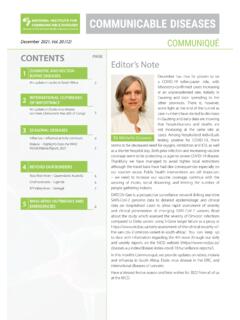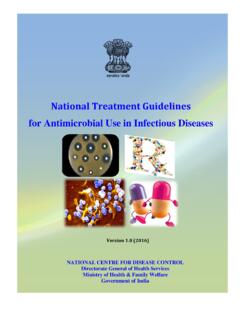Transcription of Guidelines for Prevention and Treatment of Opportunistic ...
1 Department of health and human servicesCenters for Disease Control and PreventionRecommendations and Reports April 10, 2009 / Vol. 58 / No. RR-4 Morbidity and Mortality Weekly for Prevention and Treatment of Opportunistic infections in HIV-Infected Adults and AdolescentsRecommendations from CDC, the National Institutes of Health, and the HIV Medicine Association of the Infectious Diseases Society of AmericaINSIDE: Continuing Education Examination MMWR Editorial BoardWilliam L. Roper, MD, MPH, Chapel Hill, NC, ChairmanVirginia A. Caine, MD, Indianapolis, INDavid W. Fleming, MD, Seattle, WAWilliam E. Halperin, MD, DrPH, MPH, Newark, NJMargaret A. Hamburg, MD, Washington, DCKing K. Holmes, MD, PhD, Seattle, WADeborah Holtzman, PhD, Atlanta, GAJohn K. Iglehart, Bethesda, MDDennis G. Maki, MD, Madison, WISue Mallonee, MPH, Oklahoma City, OKPatricia Quinlisk, MD, MPH, Des Moines, IAPatrick L.
2 Remington, MD, MPH, Madison, WIBarbara K. Rimer, DrPH, Chapel Hill, NCJohn V. Rullan, MD, MPH, San Juan, PRWilliam Schaffner, MD, Nashville, TNAnne Schuchat, MD, Atlanta, GADixie E. Snider, MD, MPH, Atlanta, GAJohn W. Ward, MD, Atlanta, GAThe MMWR series of publications is published by the Coordinating Center for Health Information and Service, Centers for Disease Control and Prevention (CDC), Department of Health and Human Services, Atlanta, GA Citation: Centers for Disease Control and Prevention . [Title]. MMWR 2009;58(No. RR-#):[inclusive page numbers].Centers for Disease Control and PreventionRichard E. Besser, MD(Acting)DirectorTanja Popovic, MD, PhDChief Science OfficerJames W. Stephens, PhDAssociate Director for ScienceSteven L. Solomon, MDDirector, Coordinating Center for Health Information and ServiceJay M. Bernhardt, PhD, MPHD irector, National Center for Health MarketingKatherine L.
3 Daniel, PhDDeputy Director, National Center for Health MarketingEditorial and Production StaffFrederic E. Shaw, MD, JDEditor, MMWR SeriesSusan F. Davis, MD(Acting) Assistant Editor, MMWR SeriesTeresa F. RutledgeManaging Editor, MMWR SeriesDavid C. Johnson(Acting) Lead Technical Writer-EditorSuzanne M. Hewitt, MPAP roject EditorMartha F. BoydLead Visual Information SpecialistMalbea A. LaPeteStephen R. SpriggsVisual Information SpecialistsKim L. Bright, MBAQ uang M. Doan, MBAP hyllis H. KingInformation Technology SpecialistsDisclosure of RelationshipCDC, our planners, and our content specialists wish to disclose they have no finan-cial interests or other relationships with the manufacturers of commercial products, suppliers of commercial services, or commercial supporters, with the exception of Constance Benson and King K. Holmes. Dr. Benson discloses being on the Advisory Board for Merck, GlaxoSmithKline, and Boehringer Ingelheim; being a grant recipient for Gilead; and being a Data Safety Monitoring Board (DSMB) member for Achillion and JJR Australia.
4 Her spouse also is a consultant for Merck, Gilead, Achillion, Monogram, and Vertex. Dr. Holmes discloses being a DSMB member of Merck, receiving an honorarium at the 2005 Infectious Diseases Society of America Conference, and serving on the Mycology Research Laboratories scientific advisory board. Presentations will not include any discussion of the unlabeled use of a product or a product under investigational ..1 Introduction ..2 History of the Guidelines ..2 Guidelines Process ..2 Major Changes in Guidelines Since Last Publication ..3 How to Use the Information in this Report ..3 Effect of ART on the Management of OIs ..4 Initiation of ART in the Setting of an Acute OI ( Treatment -Na ve Patients) ..4 Management of Acute OIs in Patients Receiving ART ..5 Special Considerations During Pregnancy ..5 Disease Specific Recommendations ..6 Pneumocystis Pneumonia.
5 6 Toxoplasma gondii Encephalitis ..10 Cryptosporidiosis ..14 Microsporidiosis ..17 Mycobacterium tuberculosis Infection and Disease ..19 Disseminated Mycobacterium avium Complex Disease ..28 Bacterial Respiratory Disease ..31 Bacterial Enteric infections ..36 Bartonellosis ..39 Syphilis ..41 Mucocutaneous Candidiasis ..45 Cryptococcosis ..48 Histoplasmosis ..50 Coccidioidomycosis ..52 Aspergillosis ..54 Cytomegalovirus Disease ..55 Herpes Simplex Virus Disease ..61 HHV-6 and HHV-7 Disease ..63 Varicella-Zoster Virus Diseases ..64 Human Herpesvirus-8 Disease ..66 Human Papillomavirus Disease ..68 Hepatitis B Virus Infection ..75 Hepatitis C Virus Infection ..84 Progressive Multifocal Leukoencephalopathy/JC Virus Infection ..91 Geographic OIs of Specific Consideration ..94 Malaria ..94 Penicilliosis marneffei ..98 Leishmaniasis ..99 Chagas Disease ..103 Isosporiasis.
6 105 References ..107 Tables ..145 Figures ..197 Appendix ..199 List of Abbreviations Used in this Report ..204 Contributors ..206 Continuing Education Activity ..CE-1 Vol. 58 / RR-4 Recommendations and Reports 1 Guidelines for Prevention and Treatment of Opportunistic infections in HIV-Infected Adults and AdolescentsRecommendations from CDC, the National Institutes of Health, and the HIV Medicine Association of the Infectious Diseases Society of AmericaPrepared byJonathan E. Kaplan, MD1 Constance Benson, MD2 King K. Holmes, MD, PhD3 John T. Brooks, MD1 Alice Pau, PharmD4 Henry Masur, MD41 CDC, Atlanta, Georgia2 University of California San Diego, San Diego, California 3 University of Washington, Seattle, Washington4 National Institutes of Health, Bethesda, MarylandSummaryThis report updates and combines earlier versions of Guidelines for the Prevention and Treatment of Opportunistic infections (OIs) in HIV-infected adults ( , persons aged >18 years) and adolescents ( , persons aged 13 17 years), last published in 2002 and 2004, respectively.
7 It has been prepared by the Centers for Disease Control and Prevention (CDC), the National Institutes of Health (NIH), and the HIV Medicine Association (HIVMA) of the Infectious Diseases Society of America (IDSA). The Guidelines are intended for use by clinicians and other health-care providers, HIV-infected patients, and policy makers in the United States. These Guidelines address several OIs that occur in the United States and five OIs that might be acquired during international travel. Topic areas covered for each OI include epidemiology, clinical manifestations, diagnosis, Prevention of exposure; Prevention of disease by chemoprophylaxis and vac-cination; discontinuation of primary prophylaxis after immune reconstitution; Treatment of disease; monitoring for adverse effects during Treatment ; management of Treatment failure; Prevention of disease recurrence; discontinuation of secondary prophylaxis after immune reconstitution; and special considerations during Guidelines were developed by a panel of specialists from the United States government and academic institutions.
8 For each OI, a small group of specialists with content-matter expertise reviewed the literature for new information since the Guidelines were last pub-lished; they then proposed revised recommendations at a meeting held at NIH in June 2007. After these presentations and discussion, the revised Guidelines were further reviewed by the co-editors; by the Office of AIDS Research, NIH; by specialists at CDC; and by HIVMA of IDSA before final approval and recommendations are rated by a letter that indicates the strength of the recommendation and a Roman numeral that indicates the quality of evidence supporting the recommendation, so that readers can ascertain how best to apply the recommendations in their practice changes in the Guidelines include 1) greater emphasis on the importance of antiretroviral therapy for the Prevention and treat-ment of OIs, especially those OIs for which no specific therapy exists; 2) information regarding the diagnosis and management of immune reconstitution inflammatory syndromes.
9 3) information regarding the use of interferon-gamma release assays for the diagnosis of latent Mycobacterium tuberculosis (TB) infection; 4) updated information concerning drug interactions that affect the use of rifamycin drugs for Prevention and Treatment of TB; 5) the addition of a section on hepatitis B virus infection; and 6) the addition of malaria to the list of OIs that might be acquired during international report includes eleven tables pertinent to the Prevention and Treatment of OIs, a figure that pertains to the diagnois of tubercu-losis, a figure that describes immunization recommendations, and an appendix that summarizes recommendations for Prevention of exposure to Opportunistic material in this report originated in the National Center for HIV/AIDS, Viral Hepatitis, STD, and TB Prevention , Kevin Fenton, MD, preparer: John T. Brooks, , Division of HIV/AIDS Prevention , NCHHSTP, CDC, 1600 Clifton Road NE, MS E-45, Atlanta, GA 30333, Telephone: 404-639-3894, Fax: 404-639-6127, Email: MMWR April 10, 2009 IntroductionBefore the widespread use of potent combination antiret-roviral therapy (ART), Opportunistic infections (OIs), which have been defined as infections that are more frequent or more severe because of immunosuppression in HIV-infected persons, were the principal cause of morbidity and mortality in this population.
10 In the early 1990s, the use of chemoprophylaxis, immunization, and better strategies for managing acute OIs contributed to improved quality of life and improved survival (1). However, the widespread use of ART starting in the mid-1990s has had the most profound influence on reducing OI-related mortality in HIV-infected persons in those countries in which these therapies are accessible and affordable (1 8).Despite the availability of ART in the United States and other industrialized countries, OIs continue to cause considerable morbidity and mortality for three primary reasons: 1) many patients are unaware of their HIV infection and seek medical care when an OI becomes the initial indicator of their disease; 2) certain patients are aware of their HIV infection, but do not take ART because of psychosocial or economic factors; and 3) certain patients are prescribed ART, but fail to attain adequate virologic and immunologic response because of factors related to adherence, pharmacokinetics, or unexplained biologic fac-tors (4,9,10).












